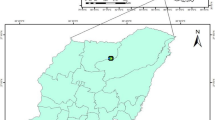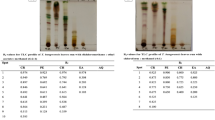Abstract
Since ancient times, bamboos have been used by different cultures in folk medicine for the treatment of many diseases, among them, bacterial infections. Brazil has a great diversity of herbaceous and woody bamboo species, many of them endemic. This study aimed to investigate the antibacterial potential of leaf extracts of seven Brazilian native bamboo species: Olyra glaberrima (OG), Parodiolyra micrantha (PM), Aulonemia aristulata (AA), Filgueirasia arenicola (FA), Filgueirasia cannavieira (FC), Merostachys neesii (MN), and Merostachys pluriflora (MP). Antibacterial activity of hexane (HE), hydroethanol (EE), and aqueous (AE) extracts from bamboo leaves were evaluated by the broth microdilution method against Pseudomonas aeruginosa and Escherichia coli (Gram-negative bacteria), and Bacillus subtilis (Gram-positive bacterium). Hexane extracts were the most active against all bacteria tested and showed a bacteriostatic effect. Hexane extracts of OG, FC, and MP inhibited the growth of B. subtilis; IC50: 0.39, 0.86, and 0.87 mg mL−1, respectively. Almost all HE was active against E. coli, exception for OG and FA extracts; furthermore, the HE of MP was the most active against E. coli, showing the lowest IC50 (1.12 mg mL−1). Overall, the extracts were more promising against P. aeruginosa with HE of MP being the most active extract (IC50: 0.36 mg mL−1). In conclusion, Brazilian native bamboos, like the Asian ones, showed antibacterial activity. Moreover, the most promising studied species was M. pluriflora; HE of MP inhibited the growth of the three bacteria tested.

Similar content being viewed by others
References
Afrin T, Tsuzuki T, Kanwar RK, Wang X (2012) The origin of the antibacterial property of bamboo. J Text Inst 103:844–849. https://doi.org/10.1080/00405000.2011.614742
Austria KC, Waing KGD, Valentino MJ (2017) Anti-oxidant and antibacterial potential of Bambusa blumeana J. A. and J. H. Schultes and Bambusa vulgaris Schrad. Ex Wendl. shoot extracts. Int J Biol Pharm Allied Sci 6:2175–2188
Bamboo Phylogeny Group (BPG) (2012) An updated tribal and subtribal classification of the bamboos (Poaceae: Bambusoideae). Bamboo Sci Cult 24:1–10
Bansal AK, Zoolagud SS (2002) Bamboo composites: material of the future. J Bamboo Ratt 1:119–130. https://doi.org/10.1163/156915902760181595
Blair JMA, Webber MA, Baylay AJ, Ogbolu DO, Piddock LJV (2015) Molecular mechanisms of antibiotic resistance. Nat Rev Microbiol 13:42–51. https://doi.org/10.1038/nrmicro3380
Brown D (2015) Antibiotic resistance breakers: can repurposed drugs fill the antibiotic discovery void? Nat Rev Drug Discov 14:821–832. https://doi.org/10.1038/nrd4675
Canavan S, Richardson DM, Visser V, Le Roux JJ, Vorontsova MS, Wilson JRU (2017) The global distribution of bamboos: assessing correlates of introduction and invasion. AoB Plants 9:plw078. https://doi.org/10.1093/aobpla/plw078
Chongtham N, Bisht MS, Haorongbam S (2011) Nutritional properties of bamboo shoots: potential and prospects for utilization as a health food. Compr Rev Food Sci Food Saf 10:153–168. https://doi.org/10.1111/j.1541-4337.2011.00147.x
Cos P, Vlietinck AJ, Vanden Berghe D, Maes L (2006) Anti-infective potential of natural products: how to develop a stronger in vitro “proof-of-concept”. J Ethnopharmacol 106:290–302. https://doi.org/10.1016/j.jep.2006.04.003
Das M, Bhattacharya S, Singh P, Filgueiras TS, Pal A (2008) Bamboo taxonomy and diversity in the era of molecular markers. Adv Bot Res 47:225–268. https://doi.org/10.1016/S0065-2296(08)00005-0
David B, Wolfender J-L, Dias DA (2015) The pharmaceutical industry and natural products: historical status and new trends. Phytochem Rev 14:299–315. https://doi.org/10.1007/s11101-014-9367-z
Felisberto MHF, Miyake PSE, Beraldo AL, Clerici MTPS (2017) Young bamboo culm: potential food as source of fiber and starch. Food Res Int 101:96–102. https://doi.org/10.1016/j.foodres.2017.08.058
Fujimura M, Ideguchi M, Minami Y, Watanabe K, Tadera K (2005) Amino acid sequence and antimicrobial activity of chitin-binding peptides, Pp-AMP 1 and Pp-AMP 2, from Japanese bamboo shoots (Phyllostachys pubescens). Biosci Biotechnol Biochem 69:642–645. https://doi.org/10.1271/bbb.69.642
Gallegos-Monterrosa R, Mhatre E, Kovács ÁT (2016) Specific Bacillus subtilis 168 variants form biofilms on nutrient-rich medium. Microbiology 162:1922–1932. https://doi.org/10.1099/mic.0.000371
Giedraitiene A, Vitkauskiene A, Naginiene R, Pavilonis A (2011) Antibiotic resistance mechanisms of clinically important bacteria. Medicina (B Aires) 47:137–146. https://doi.org/10.3390/medicina47030019
Goyal AK, Middha SK, Usha T, Sen A (2017) Analysis of toxic, antidiabetic and antioxidant potential of Bambusa balcooa Roxb. leaf extracts in alloxan-induced diabetic rats. 3 Biotech 7:120. https://doi.org/10.1007/s13205-017-0776-8
Guimarães DO, da Momesso LS, Pupo MT (2010) Antibióticos: importância terapêutica e perspectivas para a descoberta e desenvolvimento de novos agentes. Quim Nova 33:667–679
Gupta MP (2018) Panamanian biodiversity: a valuable source of novel lead compounds of economic and medical potential. Pharm Pharmacol Int J 6:112. https://doi.org/10.15406/ppij.2018.06.00165
Haque AKMM, Das AK, Bashar SS, Al-Mahamud R, Rahmatullah M (2015) Analgesic and antihyperglycemic activity evaluation of Bambusa vulgaris aerial parts. J Appl Pharm Sci 5:127–130. https://doi.org/10.7324/JAPS.2015.50924
Harvey AL, Edrada-Ebel R, Quinn RJ (2015) The re-emergence of natural products for drug discovery in the genomics era. Nat Rev Drug Discov 14:111–129. https://doi.org/10.1038/nrd4510
Honfo H, Tovissodé FC, Gnanglè C, Mensah S, Salako VK, Assogbadjo AE, Agbangla C, Kakaï RG (2015) Traditional knowledge and use value of bamboo in southeastern Benin: implications for sustainable management. Ethnobot Res Appl 14:139–153. https://doi.org/10.17348/era.14.0.139-153
Jin Y-C, Yuan K, Zhang J (2011) Chemical composition, and antioxidant and antimicrobial activities of essential oil of Phyllostachys heterocycla cv. Pubescens varieties from China. Molecules 16:4318–4327. https://doi.org/10.3390/molecules16054318
Kim K-M, Kim Y-S, Lim JY, Min SJ, Ko H-C, Kim S-J, Kim Y (2015) Intestinal anti-inflammatory activity of Sasa quelpaertensis leaf extract by suppressing lipopolysaccharide-stimulated inflammatory mediators in intestinal epithelial Caco-2 cells co-cultured with RAW 264.7 macrophage cells. Nutr Res Pract 9:3–10. https://doi.org/10.4162/nrp.2015.9.1.3
Kumar PS, Kumari KU, Devi MP, Choudhary VK, Sangeetha A (2017) Bamboo shoot as a source of nutraceuticals and bioactive compounds: a review. Indian J Nat Prod Resour 8:32–46
Lodhi S, Jain AP, Rai G, Yadav AK (2016) Preliminary investigation for wound healing and anti-inflammatory effects of Bambusa vulgaris leaves in rats. J Ayurveda Integr Med 7:14–22. https://doi.org/10.1016/j.jaim.2015.07.001
Mori Y, Kuwano Y, Tomokiyo S, Kuroyanagi N, Odahara K (2019) Inhibitory effects of Moso bamboo (Phyllostachys heterocycla f. pubescens) extracts on phytopathogenic bacterial and fungal growth. Wood Sci Technol 53:135–150. https://doi.org/10.1007/s00226-018-1063-5
Mulyono N, Lay BW, Rahayu S, Yaprianti I (2012) Antibacterial activity of petung bamboo (Dendrocalamus asper) leaf extract against pathogenic Escherichia coli and their chemical identification. Int J Pharm Biol Arch 3:770–778
Naidu MA (2012) Antimicrobial activity of methanolic extracts of bamboo shoots (Bambusa vulgaris). Int J Pharm Biol Arch 3:1547–1549
Nazreen S, Kaur G, Alam MM, Haider S, Hamid H, Alam MS (2011) Hypoglycemic activity of Bambusa arundinacea leaf ethanolic extract in streptozotocin induced diabetic rats. Pharmacologyonline 1:964–972
Nirmala C, Bisht MS, Bajwa HK, Santosh O (2018) Bamboo: a rich source of natural antioxidants and its applications in the food and pharmaceutical industry. Trends Food Sci Technol 77:91–99. https://doi.org/10.1016/j.tifs.2018.05.003
Nishina A, Uchibori T (1991) Antimicrobial activity of 2,6-Dimethoxy-p-benzoquinone, isolated from thick-stemmed bamboo, and its analogs. Agric Biol Chem 55:2395–2398. https://doi.org/10.1271/bbb1961.55.2395
Ogunjinmi AA, Ijeomah HM, Aiyeloja AA (2009) Socio-economic importance of bamboo (Bambusa vulgaris) in Borgu local government area of Niger state, Nigeria. J Sustain Dev Africa 10:284–298
Parekh J, Chanda SV (2008) Antibacterial activity of aqueous and alcoholic extracts of 34 Indian medicinal plants against some Staphylococcus species. Turkish J Biol 32:63–71
Park E-J, Jhon D-Y (2010) The antioxidant, angiotensin converting enzyme inhibition activity, and phenolic compounds of bamboo shoot extracts. LWT - Food Sci Technol 43:655–659. https://doi.org/10.1016/j.lwt.2009.11.005
Sangeetha R, Diea YKT, Chaitra C, Malvi PG, Shinomol GK (2015) The amazing bamboo: a review on its medicinal and pharmacological potential. Indian J Nutr 2:1–7
Sedano-Partida MD, dos Santos KP, Sala-Carvalho WR, Silva-Luz CL, Furlan CM (2019) Anti-HIV-1 and antibacterial potential of Hyptis radicans (Pohl) Harley & J.F.B. Pastore and Hyptis multibracteata Benth. (Lamiaceae). J Herb Med. https://doi.org/10.1016/j.hermed.2019.100328
Seki T, Kida K, Maeda H (2010) Immunostimulation-mediated anti-tumor activity of bamboo (Sasa senanensis) leaf extracts obtained under “vigorous” condition. Evidence-Based Complement Altern Med 7:447–457. https://doi.org/10.1093/ecam/nen026
Senthilkumar MK, Sivakumar P, Changanakkattil F, Rajesh V, Perumal P (2011) Evaluation of anti-diabetic activity of Bambusa vulgaris leaves in streptozotocin induced diabetic rats. Int J Pharm Sci Drug Res 3:208–210
Shirasuna RT, Filgueiras TS (2013) Bambus nativos (Poaceae, Bambusoideae) no Parque Estadual das Fontes do Ipiranga, São Paulo, SP, Brasil. Hoehnea 40:315–359. https://doi.org/10.1590/s2236-89062013000200005
Shukla R, Sumit G, Sajal S, Dwivedi PK, Mishra A (2012) Medicinal importance of bamboo. Int J Biopharm Phytochem Res 1:9–15
Silva LI, Karuppusamy A, Miyajima F, Violante IMP, Bieski IGC, Balogun SO, Martins DTO (2017) Antimicrobial and antioxidant activities of selected plants used by populations from Juruena valley, legal amazon, Brazil. Int J Pharm Pharm Sci 9:179–191. https://doi.org/10.22159/ijpps.2017v9i5.17086
Singh SA, Bora TC, Singh NR (2012) Preliminary phytochemical analysis and antimicrobial potential of fermented Bambusa balcooa shoots. The Bioscan 7:391–394
Soreng RJ, Peterson PM, Romaschenko K, Davidse G, Teisher JK, Clark LG, Barberá P, Gillespie LJ, Zuloaga FO (2017) A worldwide phylogenetic classification of the Poaceae (Gramineae) II: an update and a comparison of two 2015 classifications. J Syst Evol 55:259–290. https://doi.org/10.1111/jse.12262
Soumya V, Muzib YI, Venkatesh P (2014) GC-MS characterization, in vitro antioxidant and antimicrobial activity of newly isolated oil from edible wild bamboo rice (Bambusa bambos). J Biol Act Prod from Nat 4:209–215. https://doi.org/10.1080/22311866.2014.939715
Tanaka A, Kim HJ, Oda S, Shimizu K, Kondo R (2011) Antibacterial activity of moso bamboo shoot skin (Phyllostachys pubescens) against Staphylococcus aureus. J Wood Sci 57:542–544. https://doi.org/10.1007/s10086-011-1207-9
Tanaka A, Shimizu K, Kondo R (2013) Antibacterial compounds from shoot skins of moso bamboo (Phyllostachys pubescens). J Wood Sci 59:155–159. https://doi.org/10.1007/s10086-012-1310-6
Tanaka A, Zhu Q, Tan H, Horiba H, Ohnuki K, Mori Y, Yamauchi R, Ishikawa H, Iwamoto A, Kawahara H, Shimizu K (2014) Biological activities and phytochemical profiles of extracts from different parts of bamboo (Phyllostachys pubescens). Molecules 19:8238–8260. https://doi.org/10.3390/molecules19068238
Van Hoyweghen L, De Bosscher K, Haegeman G, Deforce D, Heyerick A (2014) In vitro inhibition of the transcription factor NF-κb and cyclooxygenase by bamboo extracts. Phyther Res 28:224–230. https://doi.org/10.1002/ptr.4978
Wedler J, Daubitz T, Schlotterbeck G, Butterweck V (2014) In vitro anti-inflammatory and wound-healing potential of a Phyllostachys edulis leaf extract—identification of isoorientin as an active compound. Planta Med 80:1678–1684. https://doi.org/10.1055/s-0034-1383195
Wróblewska KB, Oliveira DCS, Grombone-Guaratini MT, Moreno PRH (2018) Medicinal properties of bamboos. IntechOpen. https://doi.org/10.5772/intechopen.82005
Web references
Merostachys in Flora do Brasil 2020 in construction. Jardim Botânico do Rio de Janeiro. Available in: http://floradobrasil.jbrj.gov.br/reflora/floradobrasil/FB13343. Accessed 29 Nov 2019
Olyra in Flora do Brasil 2020 in construction. Jardim Botânico do Rio de Janeiro. Available in: http://floradobrasil.jbrj.gov.br/reflora/floradobrasil/FB13366. Accessed 28 Nov 2019
Poaceae in Flora do Brasil 2020 in construction. Jardim Botânico do Rio de Janeiro. Available in: http://reflora.jbrj.gov.br/reflora/floradobrasil/FB102232. Accessed 02 Nov 2019
Acknowledgements
The authors would like to thank the Conselho Nacional de Desenvolvimento Científico e Tecnológico (CNPq—Process Numbers: 164152/2015-6 and 303332/2019-0) and Coordenação de Aperfeiçoamento de Pessoal de Nível Superior (CAPES) for the PhD research grants; Tarciso Filgueiras (in memoriam) for identification of Parodiolyra micrantha, Aulonemia aristulata, Filgueirasia arenicola, Filgueirasia cannavieira, Merostachys neesii, and Merostachys pluriflora and Milton Groppo Júnior for Olyra glaberrima identification; and Aline Bertinatto Cruz and Mourisa Ferreira for their technical assistance during analysis. This study was financed in part by the Coordenação de Aperfeiçoamento de Pessoal de Nível Superior – Brasil (CAPES) – Finance Code 001.
Author information
Authors and Affiliations
Contributions
FAM, JG, and MTGG collected the plant material and prepared the extracts; CMF, FAM, and JG designed the study; FAM and WRSC conducted the experiments; FAM wrote the manuscript; JG, WRSC, CMF, and MTGG revised the manuscript. All authors approved the final version of the manuscript.
Corresponding authors
Ethics declarations
Conflict of interest
The authors declare that they have no conflict of interest.
Additional information
Publisher's Note
Springer Nature remains neutral with regard to jurisdictional claims in published maps and institutional affiliations.
Electronic supplementary material
Below is the link to the electronic supplementary material.
Rights and permissions
About this article
Cite this article
Anselmo-Moreira, F., Gagliano, J., Sala-Carvalho, W.R. et al. Antibacterial potential of extracts from different Brazilian bamboo species. Braz. J. Bot 44, 309–315 (2021). https://doi.org/10.1007/s40415-020-00683-8
Received:
Revised:
Accepted:
Published:
Issue Date:
DOI: https://doi.org/10.1007/s40415-020-00683-8




